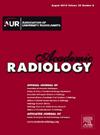Prediction of Early Recurrence After Bronchial Arterial Chemoembolization in Non-small Cell Lung Cancer Patients Using Dual-energy CT: An Interpretable Model Based on SHAP Methodology
IF 3.9
2区 医学
Q1 RADIOLOGY, NUCLEAR MEDICINE & MEDICAL IMAGING
引用次数: 0
Abstract
Rationale and Objectives
Bronchial artery chemoembolization (BACE) is a new treatment method for lung cancer. This study aimed to investigate the ability of dual-energy computed tomography (DECT) to predict early recurrence (ER) after BACE among patients with non-small cell lung cancer (NSCLC) who failed first-line therapy.
Materials and Methods
Clinical and imaging data from NSCLC patients undergoing BACE at Wenzhou Medical University Affiliated Fifth *** Hospital (10/2023–06/2024) were retrospectively analyzed. Logistic regression (LR) machine learning models were developed using 5 arterial-phase (AP) virtual monoenergetic images (VMIs; 40, 70, 100, 120, and 150 keV), while deep learning models utilized ResNet50/101/152 architectures with iodine maps. A combined model integrating optimal Rad-score, DL-score, and clinical features was established. Model performance was assessed via area under the receiver operating characteristic curve analysis (AUC), with SHapley Additive exPlanations (SHAP) framework applied for interpretability.
Results
A total of 196 patients were enrolled in this study (training cohort: n = 158; testing cohort: n = 38). The 100 keV machine learning model demonstrated superior performance (AUC = 0.751) compared to other VMIs. The deep learning model based on the ResNet101 method (AUC = 0.791) performed better than other approaches. The hybrid model combining Rad-score-100keV-A, Rad-score-100keV-V, DL-score-ResNet101-A, DL-score-ResNet101-V, and clinical features exhibited the best performance (AUC = 0.798) among all models.
Conclusion
DECT holds promise for predicting ER after BACE among NSCLC patients who have failed first-line therapy, offering valuable guidance for clinical treatment planning.
双能CT预测非小细胞肺癌患者支气管动脉化疗栓塞后早期复发:基于SHAP方法的可解释模型
理由与目的:支气管动脉化疗栓塞(BACE)是一种新的治疗肺癌的方法。本研究旨在探讨双能计算机断层扫描(DECT)对一线治疗失败的非小细胞肺癌(NSCLC)患者BACE术后早期复发(ER)的预测能力。材料与方法:回顾性分析温州医科大学附属第五医院2023年10月~ 2024年6月行BACE治疗的非小细胞肺癌患者的临床及影像学资料。Logistic回归(LR)机器学习模型采用5个动脉期(AP)虚拟单能图像(VMIs);40、70、100、120和150 keV),而深度学习模型使用带有碘图的ResNet50/101/152架构。建立了最优rad评分、dl评分和临床特征相结合的组合模型。通过受试者工作特征曲线分析(AUC)下的面积评估模型性能,采用SHapley加性解释(SHAP)框架评估可解释性。结果:本研究共纳入196例患者(训练队列:n=158;测试队列:n=38)。与其他vmi相比,100 keV机器学习模型表现出优越的性能(AUC=0.751)。基于ResNet101方法的深度学习模型(AUC=0.791)优于其他方法。结合rad -score- 100kv - a、rad -score- 100kv - v、DL-score-ResNet101-A、DL-score-ResNet101-V与临床特征的混合模型在所有模型中表现最佳(AUC=0.798)。结论:DECT有望预测一线治疗失败的NSCLC患者BACE后ER,为临床治疗规划提供有价值的指导。
本文章由计算机程序翻译,如有差异,请以英文原文为准。
求助全文
约1分钟内获得全文
求助全文
来源期刊

Academic Radiology
医学-核医学
CiteScore
7.60
自引率
10.40%
发文量
432
审稿时长
18 days
期刊介绍:
Academic Radiology publishes original reports of clinical and laboratory investigations in diagnostic imaging, the diagnostic use of radioactive isotopes, computed tomography, positron emission tomography, magnetic resonance imaging, ultrasound, digital subtraction angiography, image-guided interventions and related techniques. It also includes brief technical reports describing original observations, techniques, and instrumental developments; state-of-the-art reports on clinical issues, new technology and other topics of current medical importance; meta-analyses; scientific studies and opinions on radiologic education; and letters to the Editor.
 求助内容:
求助内容: 应助结果提醒方式:
应助结果提醒方式:


